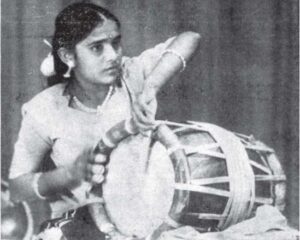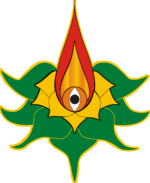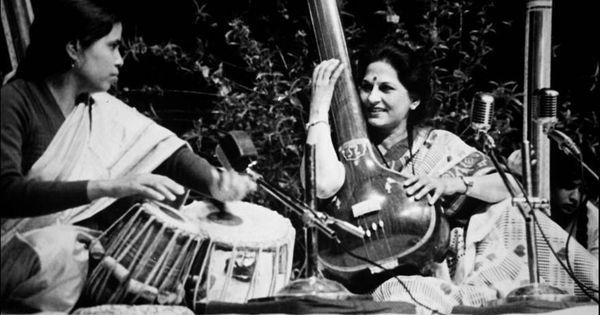This article was first published in the print edition of Manushi Journal. (Issue-33, 1986)
The second all India women’s sangit sammelan, held in New Delhi on March 8 and 9, 1986, was distinguished by the high standard of achievement of the participants. The group which organized the sammelan was Geetika, founded by Dr Shanno Khurana, who also performed.
The two day programme was spread over three sessions and consisted of a tal vadya kacheri, a flute recital, a sitar jugalbandi, a panch veena concert, tabla solos, and three forms of vocal music: khayal, light classical, and dhrupad.
The two sitarists, who played a duet, Suneera Kasliwal from Delhi and Reshma Shrivastava from Allahabad, had only one day to practise together. Shobha Kudesia from Bareilly, who is a table player, was asked about three months before the sammelan whether she would be able to play the pakhawaj for the dhrupad recital by Sumati Mutatkar. Shobha courageously set to work practising. She put in a commendable performance when the time came and became the first woman to play the pakhawaj for a dhrupad recital.
I had an opportunity to meetsome of the women who took part in the sammelan and was able to learn a little about their problems and work. Shannoji, who is the originator of the idea of an all women music festival, is also the guiding spirit behind it. She was inspired to organise it because in her 40 year career as a classical singer Shannoji had realised that although there are so many talented and accomplished women musicians today, it is more difficult for women than for men classical musicians to find the financial and organizational backing necessary to achieve professional status. Therefore, she feared that classical music might die out amongst women.
She pointed out that even though music education is now more widely available, being offered in universities and colleges as a course, the spread of education is not enough to develop students into artists. A professional attitude and sound backing are also necessary. Shannoji pointed out that in many sections of society, particularly in northern India, a stigma is still attached to female performing artists. Often, when she has invited talented young girls to work with her in her operas, their parents have refused permission, saying:
“Shanno ji, stage per nahin” Shannoji firmly believes that a conscious effort must be made to encourage professionalism among women classical musicians and a system of music management introduced. Under such a system, musicians could be freed from the tension of making appointments, arranging tours, and finding sponsors.
I also met Dr Aban Mistry, the renowned tabla player and music scholar from Bombay. Hers is a particularly tough field, because it is completely dominated by men. Originally, she had set her heart on being a Kathak dancer, but it was not to be. At age14, after a stomach ailment and operation, she was forbidden to dance. She was rescued from misery and self pity by Pt. Keki S. Jijina, who began to teach her tabla because he had seen that her understanding of rhythm was very good. He told her: “Jahan nach se palnmchti, vahin pahunchayenge.” Later on, Abanji’s talent and devotion to music was noticed by the late Ustad Amees Husain Khan who offered to help her perfect her skills. Abanji received the unstinting support of these two fine men but, in general, she has faced problems as a performer in a male dominated environment. She explained that men used to bother her so, finally, she began to use the title “Shrimati” before her name, even though she is not married.
Her experience has shown her that “when a woman performs, the old attitude comes back somewhere in the minds and eyes of men..”
Abanji has made a significant contribution to musicology with the publication in 1984 of her book Pakhawaj aur tabla ke gharane evam paramparayen. She did the research for this book, helped by Pandit Jijina, over a period of 10 years. She travelled all over the country, from village to village, wherever material was to be found, often sleeping under trees in temple courtyards. The NCPA Quarterly Journal has said that the book “must be regarded as an important landmark in the history and development of percussion instruments. It has thus become a source book on the subject.”
I was also able to meet the five member tal vadya kacheri, percussion group from Bangalore. In this group the konokol, Smt. Jaganmatha Vasudeva Murthy, who speaks out the drum syllables, is an accomplished mrudangam player. As a young woman she had become an acclaimed performer, but then she had to stop for the sake of marriage and children: “I felt very bad, but one needs time and peace of mind to practise so I remained quiet.” She has come back to the stage after about 20 years. In contrast to the experience of Smt. Vasudeva Murthy stands that of the younger members of the group. It was encouraging to learn that Geetha Shrinidhi, the ghatam player, and K. Shashikala, the mrudangam player both got married on condition that they be permitted to continue their practice and performances. As Geetha put it: “We cannot leave music.”

B.R. Latha, the kanjeera player, is the daughter of Shri H.P. Ramachar, an eminent mrudangam player and the founder director of the group. Latha says “I am lucky” and appreciates the fact that she is allowed by her parents to perform at concerts all over Karnataka as an accompanist. V. Goka Lakshmamma, the thavil player, at 16 is the youngest member of the group. She has given up school for the time being, to be able to devote herself full time to her music study.
The Sammelan was a massive and expensive affair to organise. It cost nearly Rs 100,000. The money was raised solely through private effort. Next time Geetika hopes to obtain more institutional and governmental support. Whether that comes about or not, we hope that Geetika will continue this pioneering work of focusing attention onthe achievements of women musicians.
THE second all India women’s sangit sammelan, held in New Delhi on March 8 and 9, 1986, was distinguished by the high standard of achievement of the participants. The group which organized the sammelan was Geetika, founded by Dr Shanno Khurana, who also performed.
The two day programme was spread over three sessions and consisted of a tal vadya kacheri, a flute recital, a sitar jugalbandi, a panch veena concert, tabla solos, and three forms of vocal music: khayal, light classical, and dhrupad.
The two sitarists, who played a duet, Suneera Kasliwal from Delhi and Reshma Shrivastava from Allahabad, had only one day to practise together. Shobha Kudesia from Bareilly, who is a table player, was asked about three months before the sammelan whether she would be able to play the pakhawaj for the dhrupad recital by Sumati Mutatkar. Shobha courageously set to work practising. She put in a commendable performance when the time came and became the first woman to play the pakhawaj for a dhrupad recital.
I had an opportunity to meetsome of the women who took part in the sammelan and was able to learn a little about their problems and work. Shannoji, who is the originator of the idea of an all women music festival, is also the guiding spirit behind it. She was inspired to organise it because in her 40 year career as a classical singer Shannoji had realised that although there are so many talented and accomplished women musicians today, it is more difficult for women than for men classical musicians to find the financial and organizational backing necessary to achieve professional status. Therefore, she feared that classical music might die out amongst women.
She pointed out that even though music education is now more widely available, being offered in universities and colleges as a course, the spread of education is not enough to develop students into artists. A professional attitude and sound backing are also necessary. Shannoji pointed out that in many sections of society, particularly in northern India, a stigma is still attached to female performing artists. Often, when she has invited talented young girls to work with her in her operas, their parents have refused permission, saying:
“Shanno ji, stage per nahin” Shannoji firmly believes that a conscious effort must be made to encourage professionalism among women classical musicians and a system of music management introduced. Under such a system, musicians could be freed from the tension of making appointments, arranging tours, and finding sponsors.
I also met Dr Aban Mistry, the renowned tabla player and music scholar from Bombay. Hers is a particularly tough field, because it is completely dominated by men. Originally, she had set her heart on being a Kathak dancer, but it was not to be. At age14, after a stomach ailment and operation, she was forbidden to dance. She was rescued from misery and self pity by Pt. Keki S. Jijina, who began to teach her tabla because he had seen that her understanding of rhythm was very good. He told her: “Jahan nach se palnmchti, vahin pahunchayenge.” Later on, Abanji’s talent and devotion to music was noticed by the late Ustad Amees Husain Khan who offered to help her perfect her skills. Abanji received the unstinting support of these two fine men but, in general, she has faced problems as a performer in a male dominated environment. She explained that men used to bother her so, finally, she began to use the title “Shrimati” before her name, even though she is not married.
Her experience has shown her that “when a woman performs, the old attitude comes back somewhere in the minds and eyes of men..”
Abanji has made a significant contribution to musicology with the publication in 1984 of her book Pakhawaj aur tabla ke gharane evam paramparayen. She did the research for this book, helped by Pandit Jijina, over a period of 10 years. She travelled all over the country, from village to village, wherever material was to be found, often sleeping under trees in temple courtyards. The NCPA Quarterly Journal has said that the book “must be regarded as an important landmark in the history and development of percussion instruments. It has thus become a source book on the subject.”
I was also able to meet the five member tal vadya kacheri, percussion group from Bangalore. In this group the konokol, Smt. Jaganmatha Vasudeva Murthy, who speaks out the drum syllables, is an accomplished mrudangam player. As a young woman she had become an acclaimed performer, but then she had to stop for the sake of marriage and children: “I felt very bad, but one needs time and peace of mind to practise so I remained quiet.” She has come back to the stage after about 20 years. In contrast to the experience of Smt. Vasudeva Murthy stands that of the younger members of the group. It was encouraging to learn that Geetha Shrinidhi, the ghatam player, and K. Shashikala, the mrudangam player both got married on condition that they be permitted to continue their practice and performances. As Geetha put it: “We cannot leave music.”
B.R. Latha, the kanjeera player, is the daughter of Shri H.P. Ramachar, an eminent mrudangam player and the founder director of the group. Latha says “I am lucky” and appreciates the fact that she is allowed by her parents to perform at concerts all over Karnataka as an accompanist. V. Goka Lakshmamma, the thavil player, at 16 is the youngest member of the group. She has given up school for the time being, to be able to devote herself full time to her music study.
The Sammelan was a massive and expensive affair to organise. It cost nearly Rs 100,000. The money was raised solely through private effort. Next time Geetika hopes to obtain more institutional and governmental support. Whether that comes about or not, we hope that Geetika will continue this pioneering work of focusing attention onthe achievements of women musicians.

